US Report on Mobile App Development
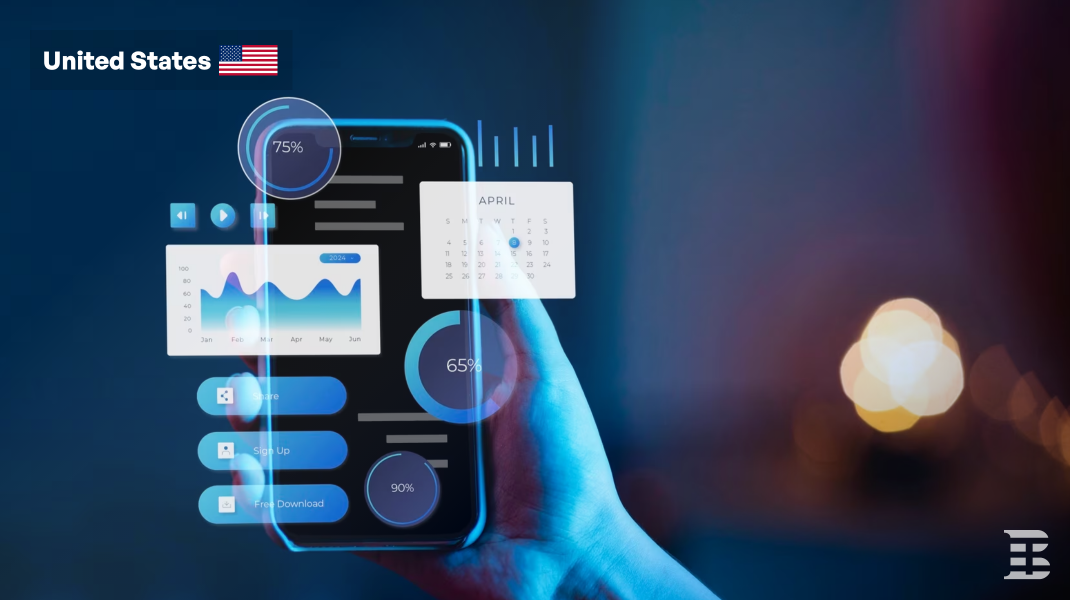
In the framework of the most recent survey on Mobile app development conducted by TechBehemoths, 83 US companies took part and revealed the costs and processes local tech companies have.
Mobile App Complexity - Delivered Projects
The first question within the survey regards the complexity of the mobile apps delivered in the past year.
The respondents indicated a distribution of mobile app complexity as delivered by US companies, and revealed the following:
- Complex Apps: Half of the apps developed by the surveyed companies are classified as "Complex". This suggests that there is a significant demand for sophisticated mobile applications with advanced features, including extensive backend services, real-time capabilities, third-party integrations, and/or intricate user interfaces. The prevalence of complex apps could be indicative of a mature market where businesses are seeking to leverage mobile platforms for more than just simple tasks.
- Medium Complexity Apps: Almost 41% of the applications fall into the "Medium" complexity category. These apps likely include a mix of standard and advanced features. They may have some level of integration with other services and a moderately complex user interface. The need for medium complexity apps could come from businesses that are looking to offer more value to their users than what simple apps can provide, but are not ready to invest in the highest level of complexity, possibly due to budget constraints or the nature of their service.
- Simple Apps: Only about 9% of the apps are classified as "Simple". This small percentage indicates that there's a relatively low demand for apps with basic functionality. Simple apps might include those that serve a single function, have no backend interaction, or have very straightforward UI/UX designs. The low demand for simple apps could be due to the abundance of do-it-yourself app builders that allow individuals and businesses to create simple apps without the need for a specialized company.
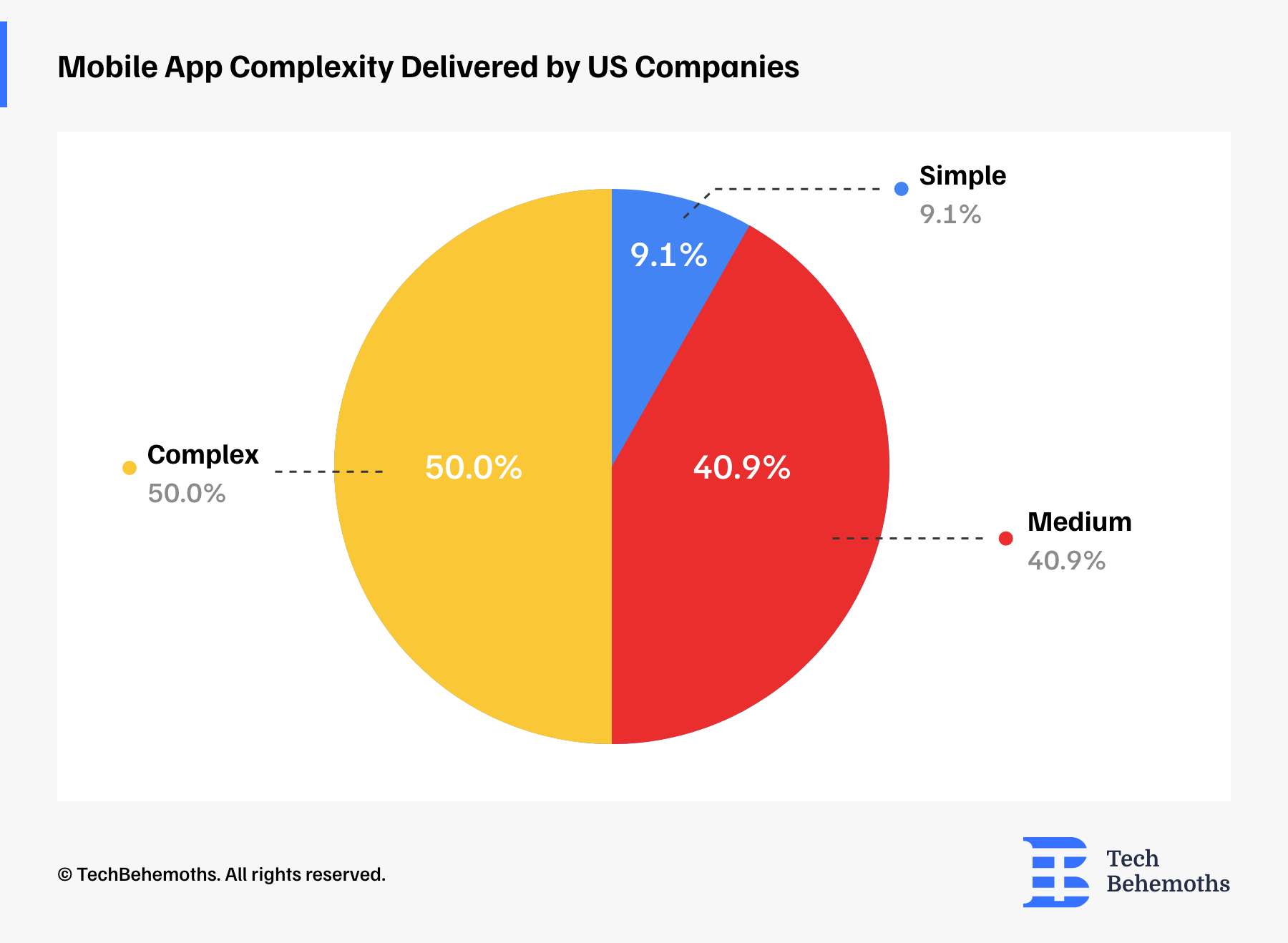
From an objective perspective this distribution reflects a trend where US companies are increasingly seeking to develop apps that provide rich features and enhanced user experiences. . Moreover, the predominance of complex app development might indicate a healthy economy where businesses are willing to invest in digital solutions that offer a competitive edge and tend to sophisticated consumer needs.
Mobile App Monetization in the US Market
When asked about the type of monetization used in the apps these companies developed, survey respondents answered the following:
- Subscription-based monetization - 63.63%
- In-App Purchases - 40.90%
- Data Monetization - 27.27%
- Free App - 22.72%
- Ads - 13.83%
- Premium App Model - 9.09%
It seems that the US mobile app monetization trends are not so far from the global trends after all, as the general survey results reveal pretty much the same image as the one from the US. But behind this there may be more reasons why US companies choose the subscription-based model as the most efficient one. Among them, there is the US consumer market familiar with subscriptions even outside their apps, the 300 million user market that makes subscriptions profitable for companies, and also the permanent cash flow that helps support the app's lifetime overall.
Of course, there are apps that include both subscription and in-app monetization. Just like in the global market, US consumers prefer to use a cheaper subscription option and then purchase in some specific cases services that go beyond the options offered in their current plan. It helps save money on the one hand, and helps app marketers understand and filter the service usage rates inside their products
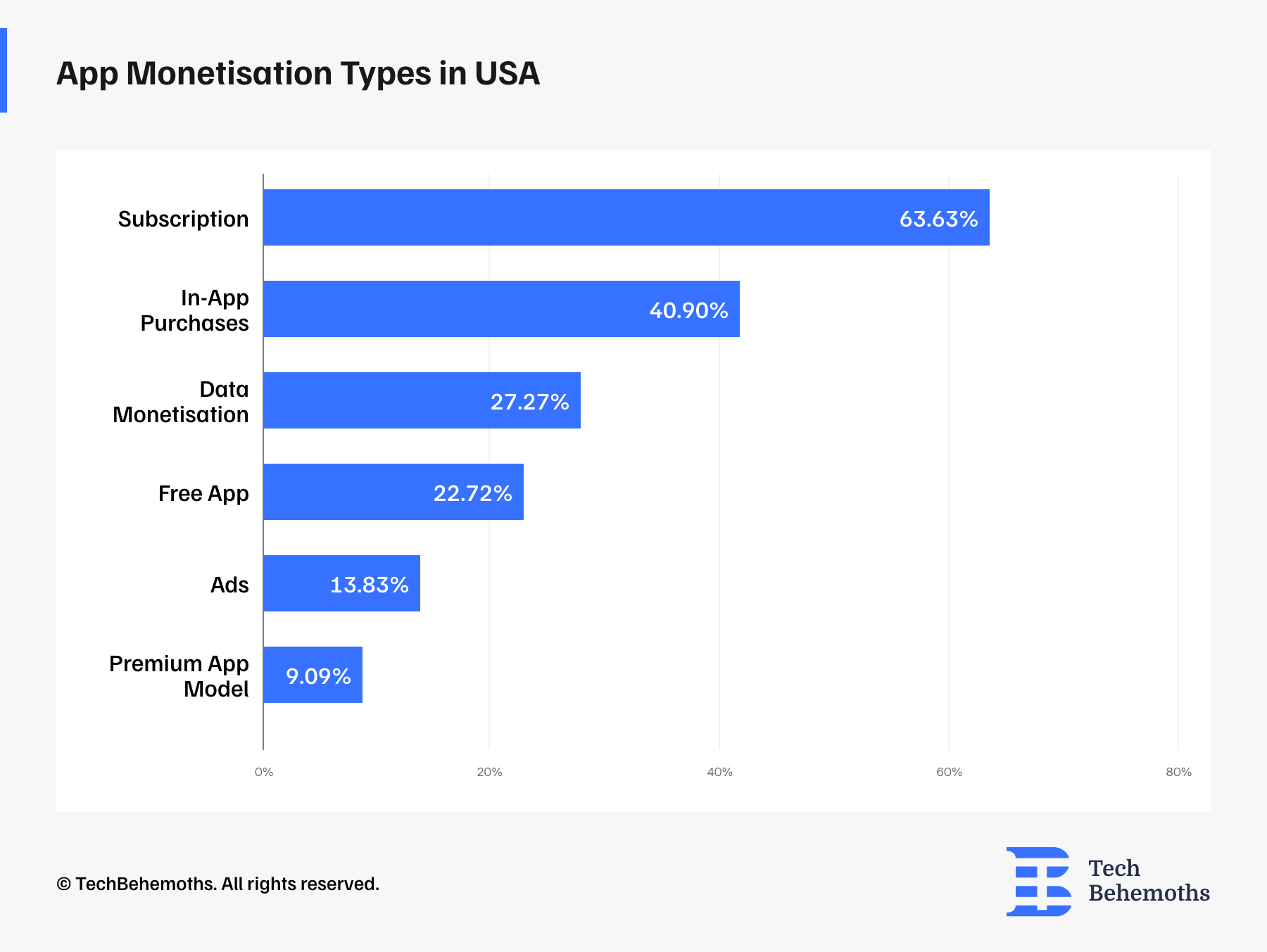
Mobile App Development - Duration
In terms of duration, the survey reveals that a significant majority, over half of the companies, reported a development duration of 5-12 months. This duration is substantial and suggests that developers are investing considerable time in creating sophisticated applications with perhaps complex features and functionalities that require extended periods of development, testing, and iteration.
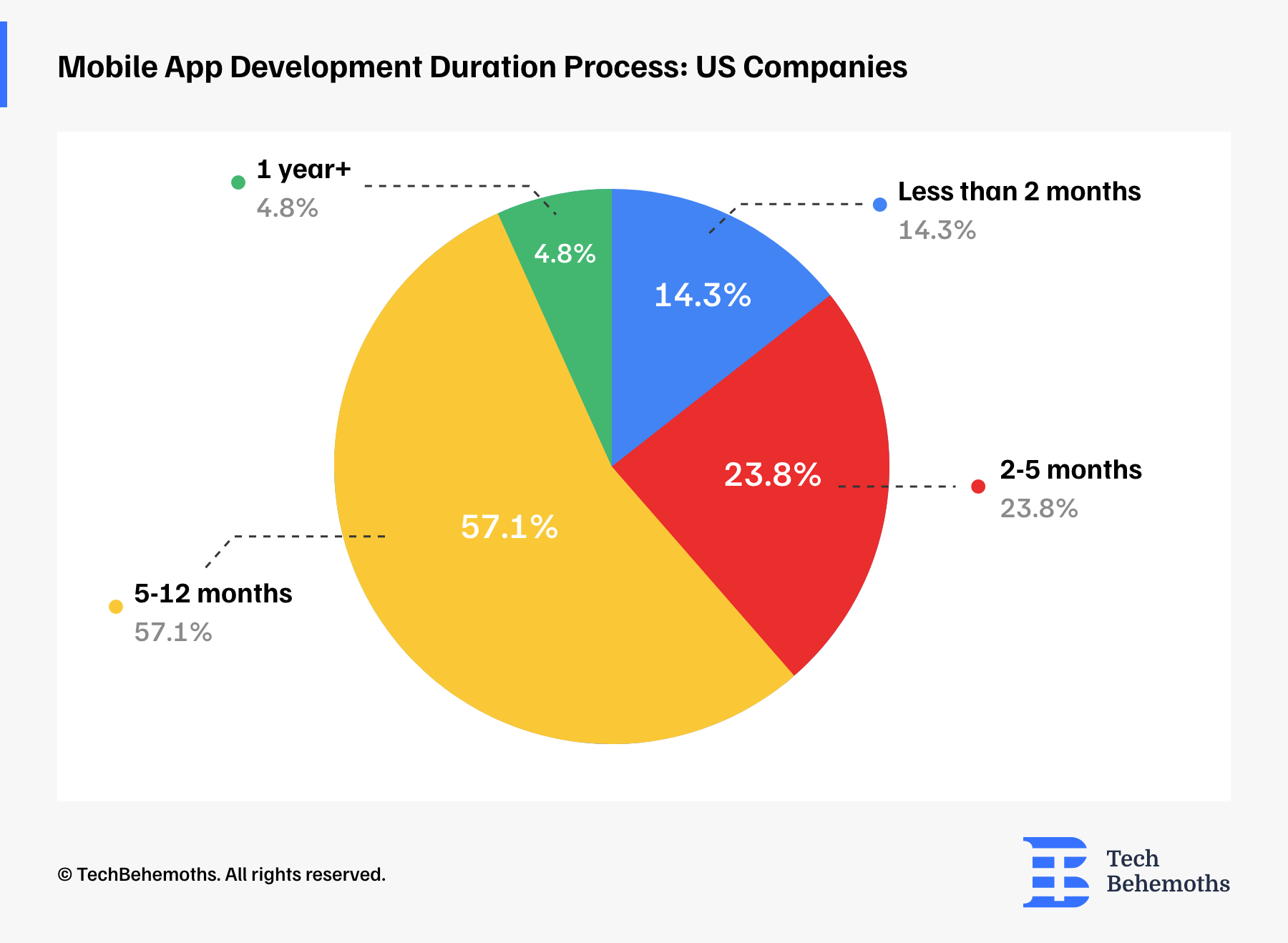
Meanwhile, nearly a quarter of the companies have a shorter development cycle of 2-5 months, which indicates a more streamlined process, likely for apps with moderate complexity or utilizing agile development methodologies that allow for faster deployment.
A smaller but noteworthy 14.3% of companies are able to deliver an app in less than two months, hinting at a focus on very basic applications or a highly efficient development process that can rapidly go from concept to market.
On the longer end of the spectrum, 4.8% of companies report development times of over a year. This could reflect either the development of highly innovative, complex, and feature-rich apps or perhaps challenges and delays in the development process.
Overall, the data reveals a picture of an industry that tailors development timelines to the scope and complexity of mobile apps, with a clear inclination towards allowing more time for the creation of well-tested applications.
Mobile App Costs in the US
Over half of the companies, precisely 54.5%, reported that the cost of developing an app exceeded $20,000. This shows that a significant portion of the market is dedicating substantial resources to app development, likely due to the complexity and feature-rich nature of the apps they are creating. It also suggests that the value proposition of having a well-designed and robust app justifies higher investment levels.
In contrast, a smaller yet notable fraction, 13.6%, managed to develop apps with a budget between $1,000 to $3,000. This lower cost range may include basic or minimal viable products, apps with limited functionality, or those developed in regions with lower labor costs. Another 13.6% of companies spent between $5,000 to $8,000, and an equal percentage allocated $8,000 to $20,000 for app development. These figures likely represent a middle ground, covering a range of apps from moderately complex to more advanced applications that require more time and expertise to develop.
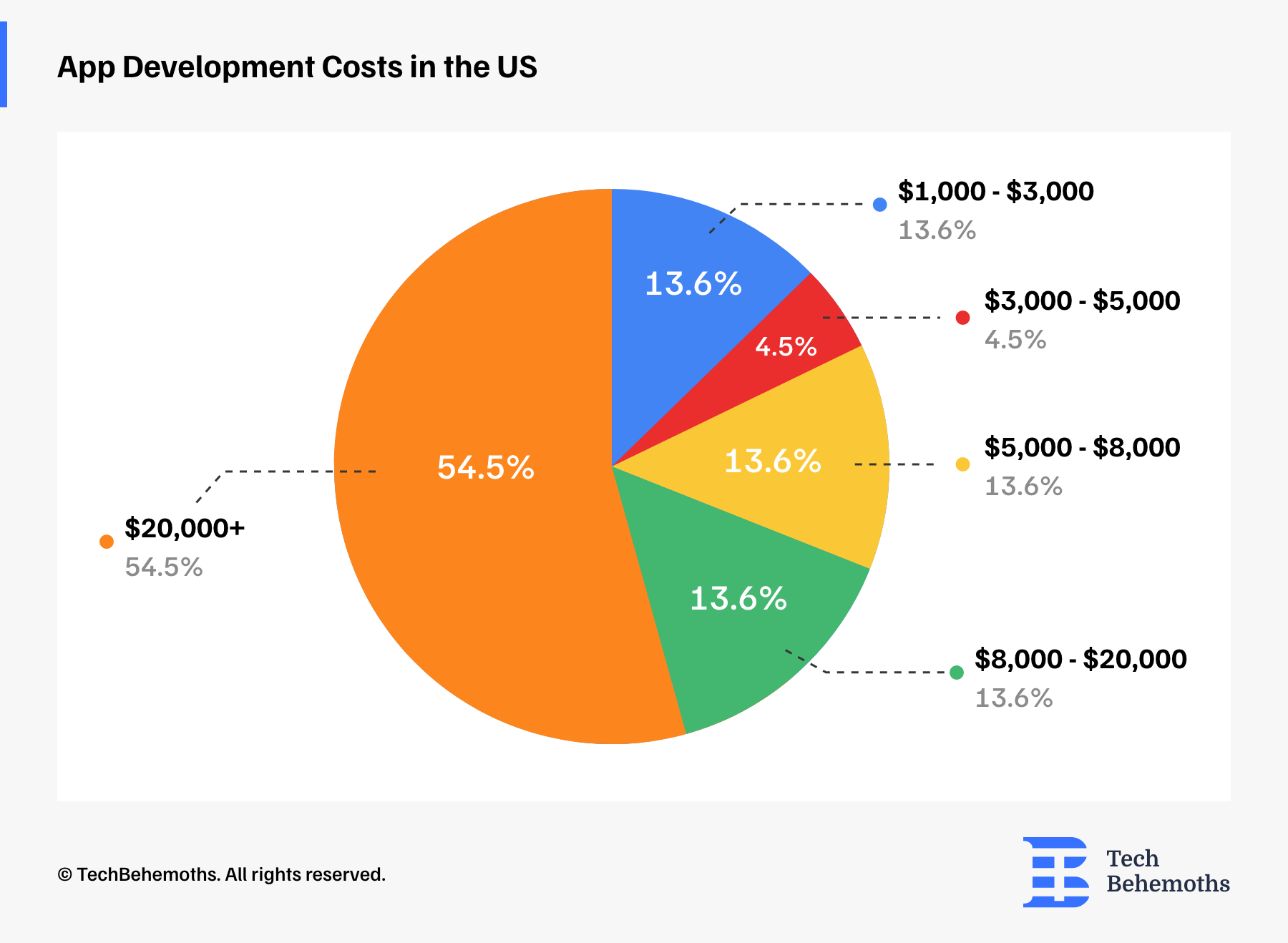
Only 4.5% of companies kept the development costs between $3,000 to $5,000, which could imply a focus on very specific, niche applications or leveraging cost-effective development strategies like cross-platform tools or pre-made app templates.
The cost distribution showcases a strong investment in mobile app development, reflecting the importance of mobile platforms in the current technology landscape. It also reveals the varying levels of financial commitment companies are willing to make, possibly aligning with their strategic objectives, target markets, and the complexity of the apps they intend to develop.
Number of assigned developers per project
The data shows a fairly even distribution between projects with smaller teams (1-3 developers) and slightly larger teams (3-5 developers), each constituting 40.9% of the projects. This may mean that mobile app development in the USA is often handled by compact teams, which could point to a preference for agile and lean development practices, or it could reflect the nature of the projects themselves—perhaps many of them do not require a large team due to their scope or complexity.
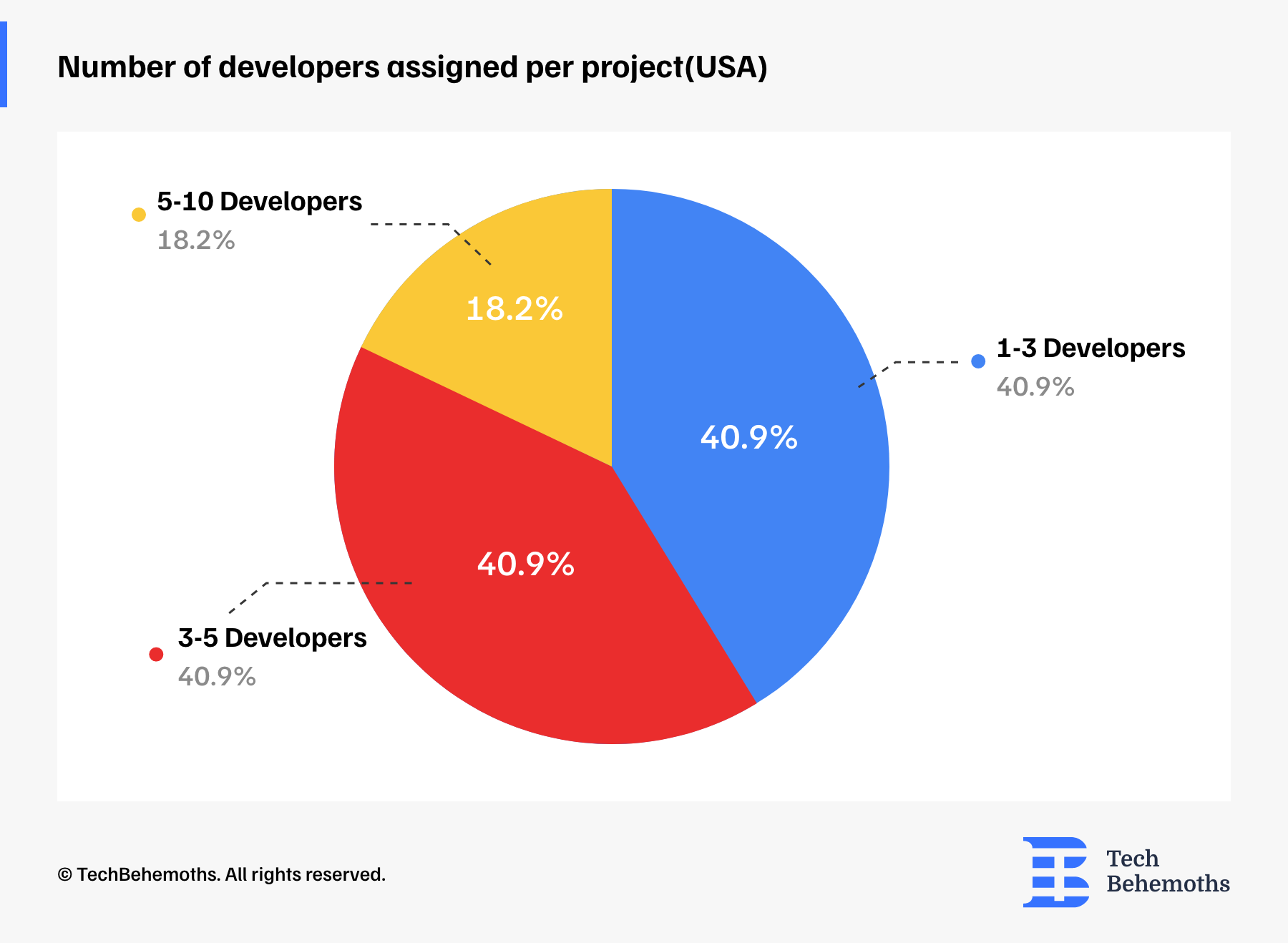
On the other hand, there is a smaller segment of projects, 18.2%, that assign 5-10 developers. These projects likely represent more complex initiatives, possibly involving sophisticated app functionalities, a need for diverse skill sets, or faster development cycles that require more hands on deck.
The fact that the vast majority of projects employ teams of 5 or fewer developers may highlight the efficiency of small, focused groups in delivering mobile app projects. It could also mean a market with a significant presence of small to medium-sized enterprises where such team sizes are optimal. This distribution of team sizes also points toward a flexible and scalable industry, where teams can be sized according to the specific demands of the project, allowing for both cost-effective development and the ability to ramp up for larger, more complex projects when needed.
Cost of Third Party Tools used by Mobile App Developers
Third-party tools in mobile app development are essential components that provide specialized functionalities or services, such as analytics, payment gateways, or advertising networks. These tools can significantly help the development process, add functional features, and improve the overall quality and user experience of the app without the need for building these components from scratch.
The survey data shows that the majority of US companies, 63.6%, spend less than $1,000 on third-party tools for mobile app development. This suggests either a market with affordable or free tools for essential services or many apps not needing high-end third-party solutions.
On the other hand, approximately 18% of companies spend between $1,000 to $5,000, which may suggest a trend towards developing complex apps that require premium third-party services with advanced analytics, enhanced user engagement, better performance, or more sophisticated app functionalities. Usually, the more expensive are the third-party tools and technologies, the higher is the project budget. It could be that the usage of a third party tool in the development process of a mobile app, could be a demand from the client. Usually, large companies have specific conditions and preferences that the developers should meet before starting the project itself.
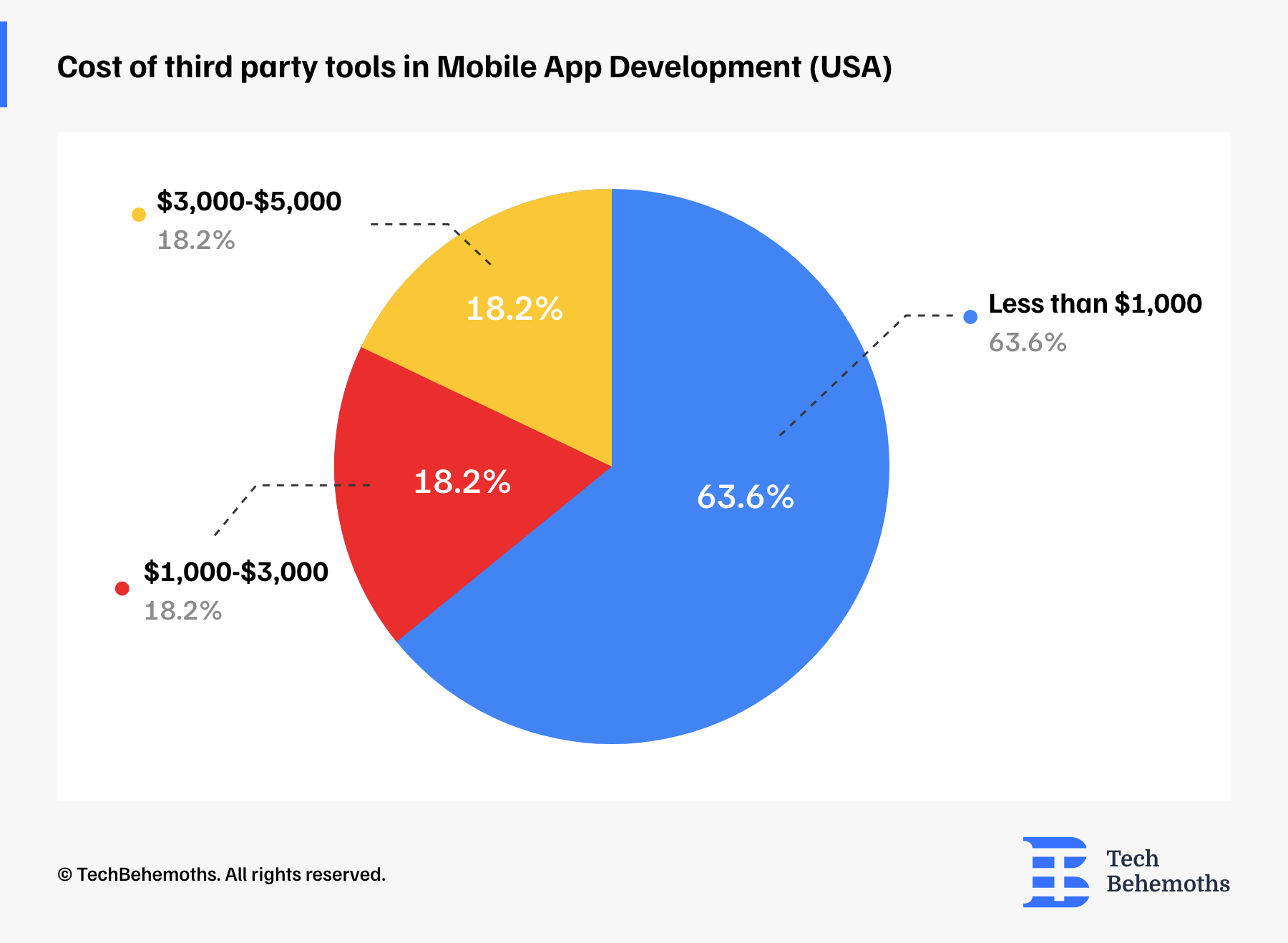
Overall though, the data presents a clear preference for economical third-party solutions in the app development process, with only a smaller proportion of companies opting for more costly tools, potentially to gain a competitive edge or meet specific project requirements that cannot be fulfilled by less expensive alternatives. T
Methodologies Used in Mobile App Development
In mobile app development, methodologies dictate the approach to planning, structuring, and controlling the process of developing an information system. A well-chosen methodology can greatly enhance the efficiency and quality of the final product, ensuring that development goals are met within constraints of time and budget.
The survey result on this topic reflects a strong dominance of the Agile methodology in the mobile app development industry in the USA, with 63.2% of companies adopting this approach. Agile is ideal for mobile app development as it allows for flexibility and iteration in response to changing requirements and user feedback.
In contrast, all other methodologies have a relatively small share, each representing 5.3% of the responses. This includes Lean, which focuses on minimizing waste and improving efficiency, and DevOps, which focuses on collaboration between software developers and IT professionals to shorten the development life cycle. The Dynamic Systems Development Model (DSDM) and Rapid Application Development (RAD) are also included, both of which are iterations of Agile methodology focusing on rapid delivery and user involvement, respectively.
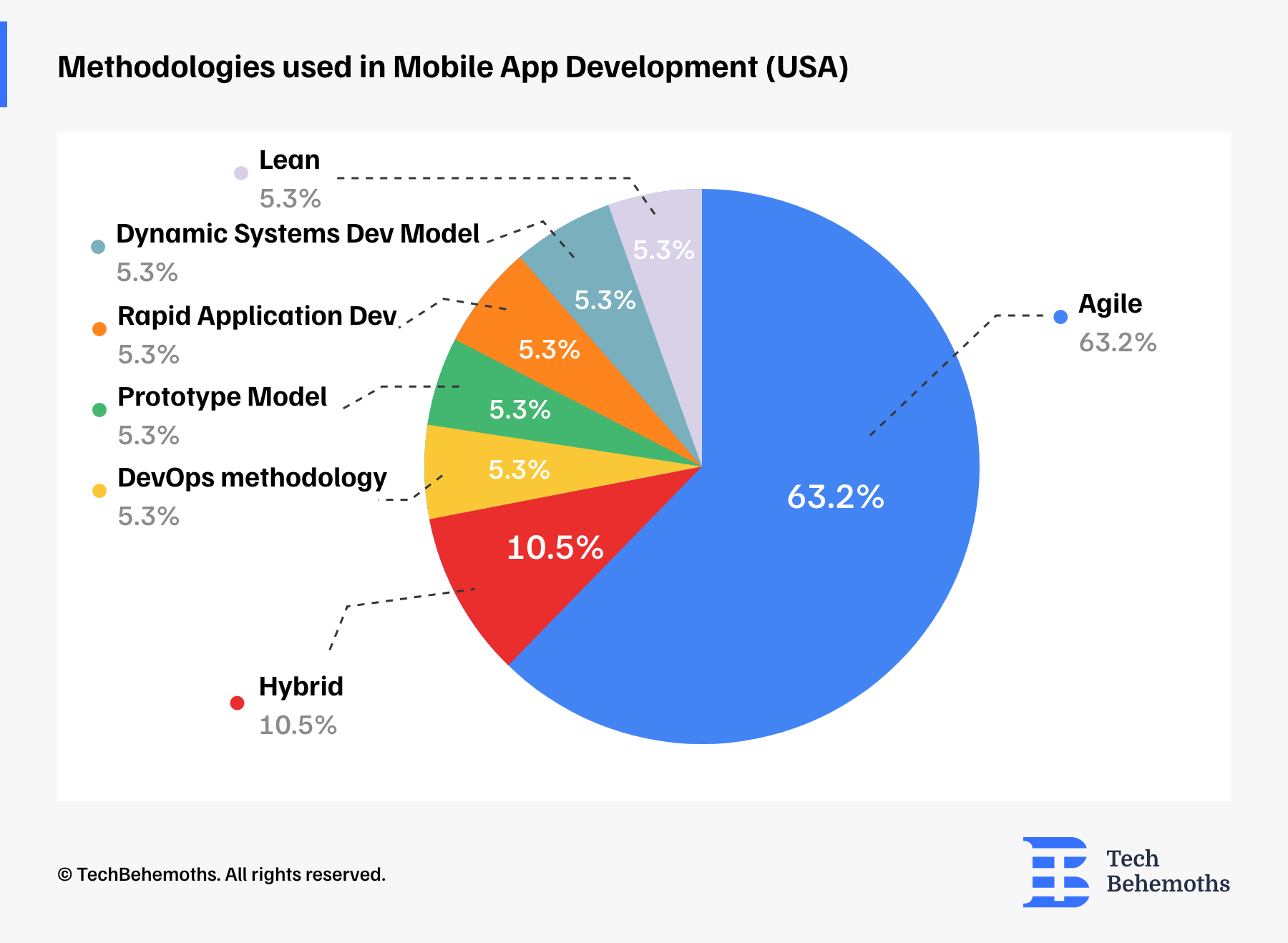
The Prototype Model is also represented, which is often used for developing prototypes to test concepts before full-scale development. Lastly, a Hybrid approach is employed by 10.5% of companies, suggesting a tailored mix of methodologies to suit specific project needs, possibly combining elements of Agile with other traditional or modern practices.
The overwhelming preference for Agile underscores the industry's prioritization of customer satisfaction, team member collaboration, and readiness to respond to change, which are all central tenets of the Agile manifesto. Meanwhile, the presence of a variety of other methodologies, though minimal, indicates that there's still a niche for alternative approaches, possibly reflecting the diverse nature of app development projects and organizational cultures within the industry.
Communication and Task Management tools used by Mobile App Development Companies
Slack emerges as the most popular tool, used by 68.18% of companies.
Jira, which is both a project management and issue tracking software, is utilized by half of the companies..
Zoom, with 27.27%, indicates the importance of video conferencing in the app development process, likely for team meetings, client presentations, or even user testing sessions.
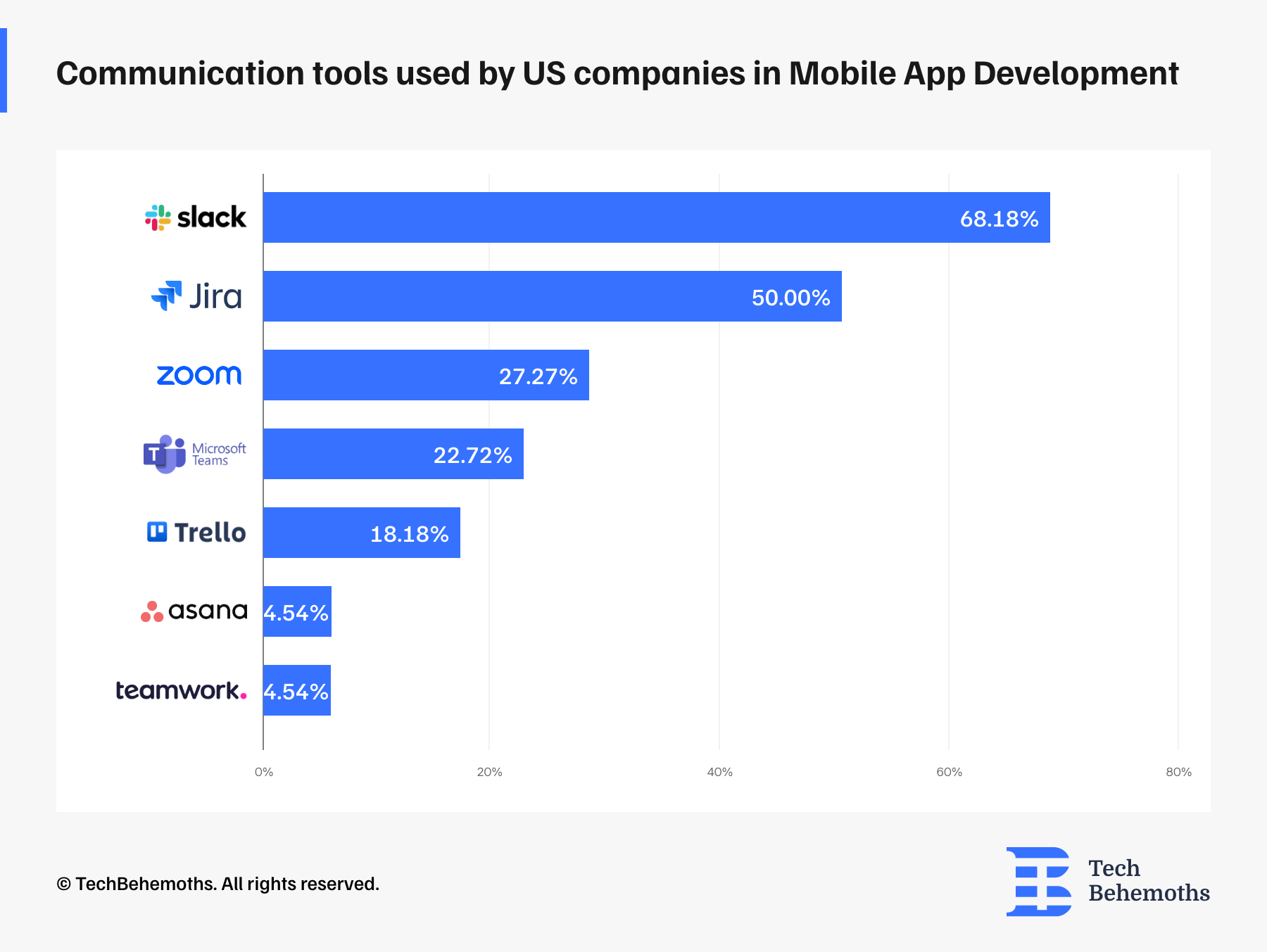
Microsoft Teams is preferred by 22.72% of companies, signifying its adoption for integrated communication, especially in environments that are already using Microsoft's ecosystem.
Trello is used by 18.18% of the companies, pointing to its user-friendly interface for task management and visual project tracking.
Finally, Asana and Teamwork, each at 4.54%, show a smaller yet significant adoption, suggesting they serve specific niches or preferences within the app development community.
Testing
Testing is a critical phase that ensures the quality and functionality of the app meets the desired standards. Various types of testing methodologies are employed to uncover different issues that could affect performance, usability, or overall user satisfaction.
In examining the testing practices of US mobile app development companies, we can observe a diverse range of methods in use. Manual testing emerges as the most commonly used technique, with 21.43% of companies relying on human testers to find bugs or issues.
User testing, which involves real users testing the app in real-world scenarios, is utilized by 18.57% of companies.
Integration testing is employed by 17.14% of companies and is a key step to ensure that individually tested units work together as a whole.
Automation testing, used by 15.71% of companies, highlights an investment in technologies that can speed up the testing process and repeat test cases precisely and quickly. It's slightly less common than manual testing, perhaps due to the initial investment required or the complexity of writing test scripts.
Unit testing stands at 14.29%, indicating a focus on testing individual components of the app for reliability, functionality, and performance.
Lastly, beta testing is practiced by 10% of companies.

Different testing methods ensure quality assurance for mobile app development in the US. US companies prioritize thorough testing of their apps to meet high user and stakeholder standards, using a blend of human-centric and automated practices for optimal performance and user experience.
Support and Maintenance
After-launch support is a crucial element that can significantly influence an app's success and longevity. Third-party tools often play a pivotal role in providing this support, enabling developers and companies to effectively address user issues, roll out updates, and manage ongoing maintenance tasks. A majority, 54.5%, opt for a dedicated team approach. This implies a commitment to offering specialized, continuous support and maintenance, which is critical for ensuring the app's performance, security, and relevance over time. Also, some 36.4% of companies employ a combination of both dedicated teams and on-call support services. A smaller segment, 9.1%, relies solely on on-call support.
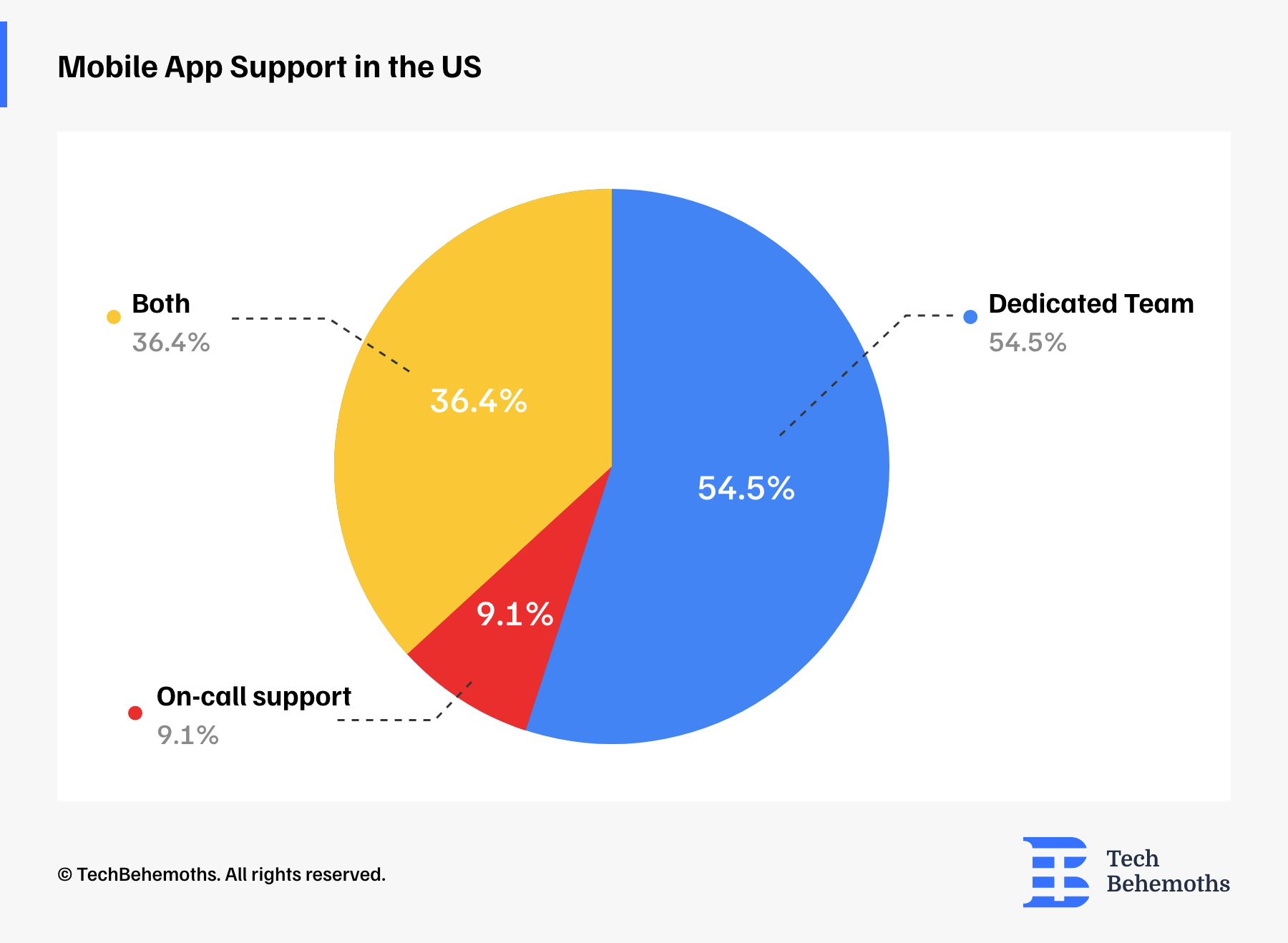
What Determines the Cost of a Mobile App?
The cost of developing a mobile app can be influenced by a series of factors, starting from technical requirements to market demand. Understanding these cost determinants is crucial for companies to budget effectively and make informed decisions throughout the development process.
In analyzing the current survey results, it's apparent that app complexity is the dominant factor, accounting for 55% of the cost determinants. Backend infrastructure is another significant cost factor, representing 30% of the determinants
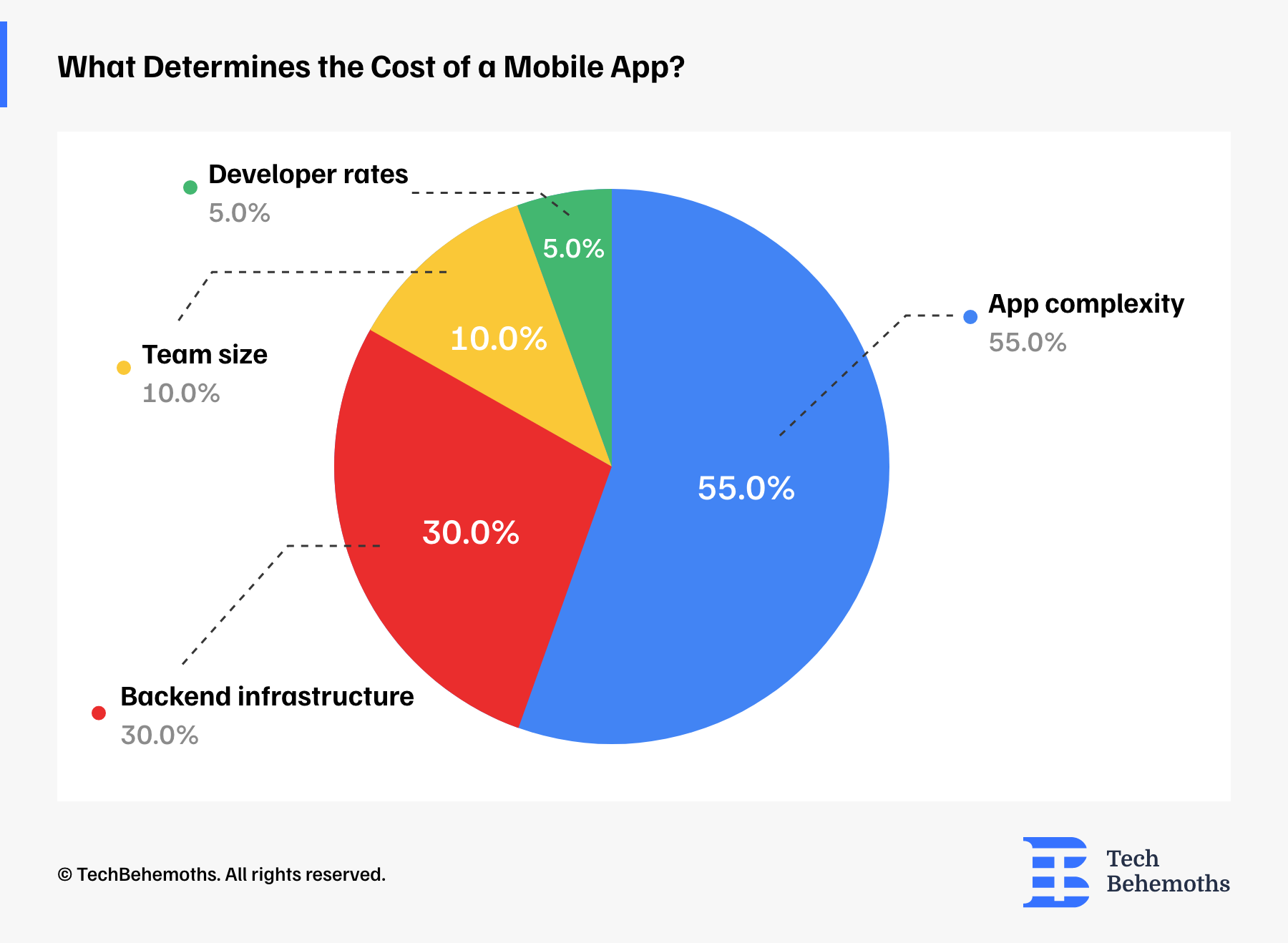
Team size contributes to 10% of the cost determination, highlighting the role that human resources play in the development process. Larger teams may be necessary for more ambitious projects but also increase the financial outlay due to salaries and management overhead.
Developer rates are the least impactful on cost, at 5%. While the expertise of developers is invaluable, it seems that the other factors weigh more heavily in the overall cost structure, possibly because developer rates are a more constant factor across projects of varying sizes and complexities.
Final Words
Overall, the current mobile app development state in the US is similar to the global one, with slightly different values in terms of methodologies and pricing. The rest of the trends are kept in line with companies from other regions, which leads us to the thought of borderless processes that don't differ too much regardless of many factors, including the geographical location of any company.